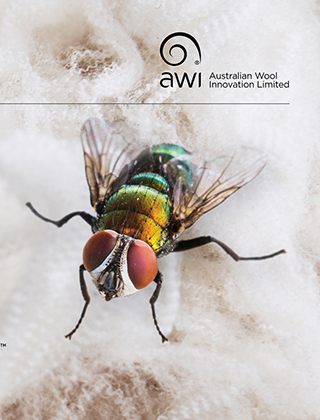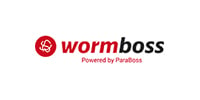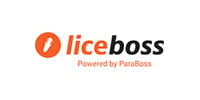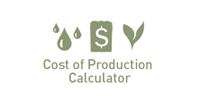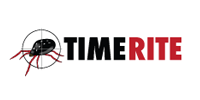Use the NWD to attract the highest price
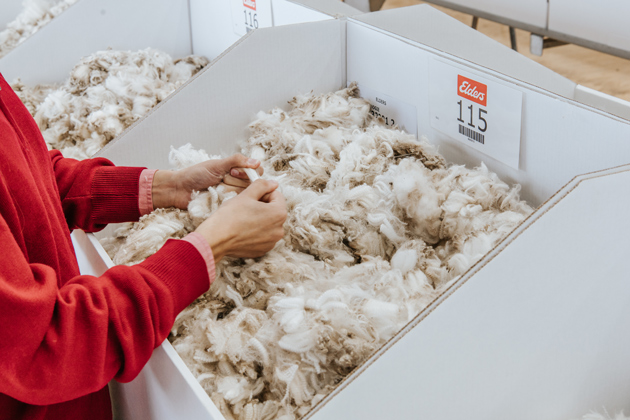
All woolgrowers are being urged to complete the National Wool Declaration (NWD), as wool sold as Not Declared usually receives a discount. The NWD provides transparency to buyers and the whole supply chain and helps woolgrowers earn Premiums and/or avoid Discounts for their wool.
Key messages
- To attract the highest price for their wool, all woolgrowers, regardless of their Mulesing Status and wool type, should ensure that their wool is accompanied by an NWD. Failure to complete an NWD has usually resulted in the wool being discounted.
- In the first six months of the 2024/25 season, 60.1% of all Tas wool and 56.9% of Tas Merino wool was either Non Mulesed (NM) or Ceased Mulesed (CM). Qld is not far behind, with 48.8% of all its wool either NM or CM and 48.1% of all its Merino wool either NM or CM.
- Nationally, declaration rates for NM wool continue to climb (currently 21.6% of all wool; 16.1% of Merino wool), as do the rates for Mulesed with Analgesic/Anaesthetic (AA) wool (currently 45.0% of all wool; 52.4% of Merino wool).
The National Wool Declaration (NWD) enables woolgrowers to communicate directly with prospective buyers, processors and retailers; and then send key wool market messages back to woolgrowers.
Whenever AWI discusses the Australian wool industry’s animal welfare with brands and retailers along the supply chain, they invariably say that they would very much like all Australian woolgrowers to declare their wool through the NWD; it creates two-way transparency, choice in the marketplace, and price signals back to growers.
Once a woolgrower has completed the NWD, which is voluntary, the contents are converted for inclusion in sale catalogues and test certificates. All woolgrowers are encouraged to complete the NWD, regardless of their sheep’s breed and wool type, and husbandry practices.
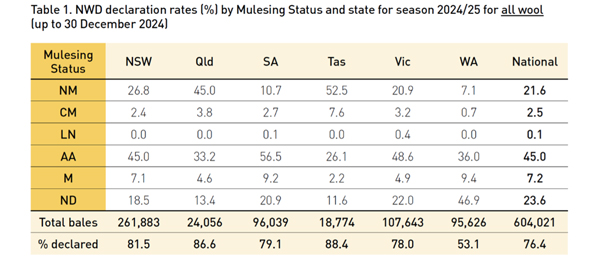
The NWD declaration rate has increased by 0.8 percentage points in the first six months of the 2024/25 season to be 76.4% up to 30 December 2024. Three states improved their declaration rate: Tas (+3.2 percentage points), Qld (+2.7), NSW (+2.3). However, there were decreases for WA (-5.4 percentage points), SA (-1.5), Vic (-0.2). Tas woolgrowers top the list for declaration rates at 88.4% of wool sold, followed by Qld woolgrowers at 86.6%. The WA declaration rate had the biggest decrease from an already low level, down to 53.1%.
Tas and Qld woolgrowers also top the NM categories at 52.5% and 45.0% of wool sold (which has been the case for a long time). These two states have the most NM wool as the risk of flystrike is lower.
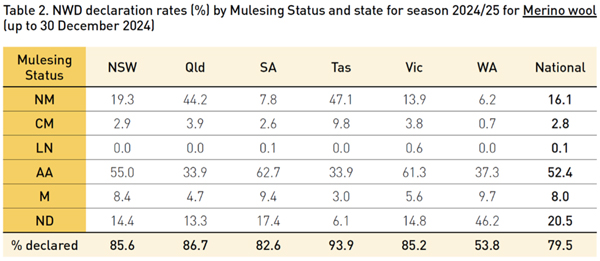
Merino wool declaration rates continue to improve nationally, up 0.7 percentage points to 79.5% for the 2024/25 season up to 30 December 2024. Three states improved their declaration rate (Merino): Qld (+2.5 percentage points), NSW (+2.0). Tas (+1.3). However, there were decreases for WA (-5.6 percentage points), SA (-1.4), Vic (-1.1). Tas woolgrowers top the list for declaration rates (Merino) at 93.9% of wool sold followed by Qld woolgrowers at 86.7% and NSW ay 85.6%. The WA declaration rate (Merino) is the lowest at 53.8%.
Compared to the previous season, the national Merino clip declared as NM rose to 16.1% (up 0.8 percentage points). All states apart from Vic and SA increased their NM declaration rate (Merino): Tas rose by 4.6 percentage points and has the highest rate of all states at 47.1%, followed by Qld which rose by 3.4 percentage points with now 44.2% (Merino) declared as NM. Both NSW and WA rose by 0.3 percentage points. Meanwhile, Vic fell by 2.4 percentage points and SA by 1.0.
Nationally, AA declarations (Merino) were up 1.5 percentage points to 52.4%. Mulesed (M) declarations (Merino) have reduced by 1.1 percentage points nationally to 8.0%. Of the Merino wool that is declared as M or AA, AA now makes up 86.5 % and M now down to 13.5%.
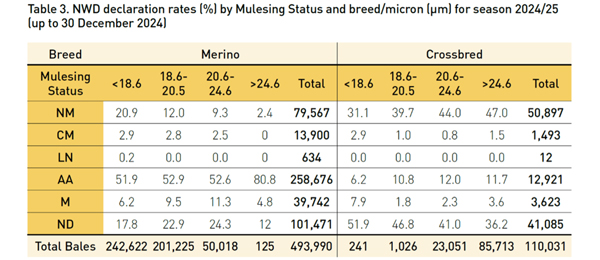
Table 3 shows that, aside from the few Merino breeders with >24.6 micron wool, it is Merino breeders with lower micron wool, less than 18.6 microns, that are most likely to declare, with only 17.8% of their wool sold not declared. By breed, the declaration rate for Merinos is 79.5%, whilst the Crossbred declaration rate is 62.7%; this appears to be a reflection of market prices as indicated in the Premium and Discount report in Table 4.
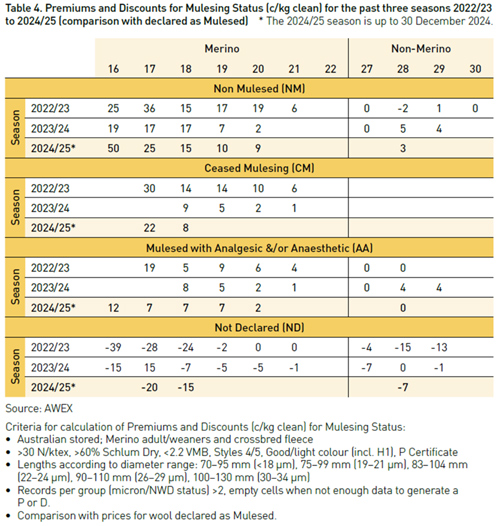
From a financial perspective, Table 4 shows that woolgrowers usually receive premiums for wool declared as NM, CM or AA. This is a greater issue for WA woolgrowers as their declaration rate is 53.1%, lower than all the other states that range from 78.0% to 88.4% wool declared.
Wool sold as ND usually receives a discount compared to wool that is declared as M. These are the averages over the selling year and if you do mules, it would likely be financially advantageous for you to complete the NWD and declare your wool as M, rather than not complete the NWD.
The message is clear. To ensure your wool attracts the highest price possible, you need to ensure that your wool for auction is accompanied by an NWD.
More information: www.awex.com.au
WoolClip achieves 96.6% NWD declaration rate in 2023/24
WoolClip, the industry’s electronic wool speci, achieved a major milestone in the 2023/24 season: a 96.6% NWD completion rate, compared to the national average of 75.4% for the 2023/24 season. More than 260,000 bales were processed through its digital wool book in the 2023/24 season.
The higher declaration rate is a testament to WoolClip’s pivotal role in transforming wool clip information, quality assurance, and traceability across Australia.
The WoolClip platform also enhances the industry’s sustainability credentials, a crucial factor as markets increasingly demand proof of environmental and ethical standards. Through features like eBale scanning and integration with the Australian Wool Sustainability Scheme (AWSS), WoolClip helps users evidence how their wool meets consumer expectations for sourcing and production.
By connecting their WoolClip account to their Australian Wool Traceability Hub profile, woolgrowers may be able to view their test data and gain insights into the buyers of their clip, depending on selling agent and buyer permissions.
woolclip@awex.com.au
AWEX 02 9428 6170
For further advice on achieving Premiums for your wool, contact your wool broker.
This article appeared in the Autumn 2025 edition of AWI’s Beyond the Bale magazine that was published in March 2025. Reproduction of the article is encouraged.






